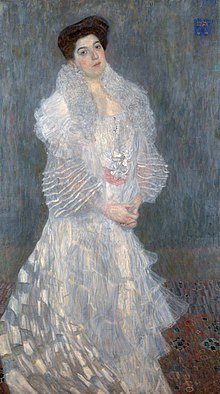
28:11
223 世紀末的維也納(II): Gustav Klimt
Woman in Gold.
Klimt名畫和維也納猶太家族的故事。
台灣上映片名:名畫的控訴
----
畫比人長壽
試找Hermine Gallia資料, Google 前3頁都是 Gustav Klimt 1904年畫的。
找到其家族資料(Wiki德文),自動翻譯成英文比較容易了解
https://de.wikipedia.org/wiki/Gallia_(Familie)
The wealthy and art-loving Jewish Gallia family from Vienna was remembered in 2011 by a book: the work Wohllebengasse published by Tim Bonyhady (* 1957), a descendant. The story of my Viennese family.
Table of Contents
1 Adolf Gallia
2 Moritz Gallia
2.1 Relationship to Klimt
2.2 Relationships with other artists
2.3 Wohllebengasse 4 house
2.4 Moritz's death
3 Gretl Gallia
4 Tim Bonyhady
5 literature
6 individual records
Adolf Gallia
Carl Auer von Welsbach, inventor of the illuminant Auer-Glühstrumpf and 1892 founder of the Austrian Gasglühlicht- (later: and electricity) company, employed the lawyer Adolf Gallia (1852-1925) with law firm and apartment in Vienna 1st, Dorotheergasse 6, with it to have his invention patented in as many countries as possible (1905 the Welsbach Light Company in Sydney, Australia). He also included the lawyer on the board of directors of his AG. The AG was based in Vienna 4th, Schleifmühlgasse 4, where Auer had previously been doing business.
Like his brother Moritz Gallia (up to 1902 spelling: Moriz), Adolf came from Bisenz near Göding in southern Moravia, i.e. from the northern area of Vienna, which was well developed by the Kaiser Ferdinands-Nordbahn (the first steam railway built in Austria).
Adolf Gallia was very successful in Auer's service. In 1903 he had Jakob Gartner build Eckhaus 1., Stubenring 24 / Dr.-Karl-Lueger-Platz 6 (now known as Café Prückel) and a second house nearby. He lived on the Stubenring with his wife Ida and also moved his law firm there. He remained in Auer's service, even when his brother left Auer's company.
Moritz Gallia
Carl Auer von Welsbach also employed the brother of his lawyer, Moritz Gallia (1858-1918, spelling before the 1902 spelling reform: Moriz), a merchant, later honored by the emperor with the title of government councilor. He soon moved up to one of the two directors of Auers Gasglühlicht-AG. [1]
Moritz Gallia was rewarded so well as a director and experienced such an increase in the value of his investments that he was able to acquire extensive shares in the company. In 1901 he had a portrait of Ferdinand Andri, and subsequently also the children. Moritz and Hermine Gallia, née Hamburgers (1870-1936; great-grandmother Tim Bonyhadys) converted to Christianity in 1910 after having had their young children baptized Catholic earlier.
Relationship to Klimt
Moritz Gallia could afford to have his wife Hermine painted by Gustav Klimt in 1903, even though he had to pay about three annual salaries for today's employees. Klimt was at that time because of his “faculty pictures”, which were commissioned by the k.k. Ministry of Education for the University of Vienna were created, very controversial, but nevertheless successful. From November 14, 1903 to January 6, 1904, he exhibited almost the entire work of his last six years, including the still unfinished portrait of Hermione Gallia, with the XVIII. Exhibition of the Vienna Secession, whereby Josef Hoffmann and Kolo Moser arranged the exhibition and Moser designed the catalog. [2] [3] The Gallia couple bought one of Klimt's new paintings, a forest scene, at the exhibition.
Relationships with other artists
In addition to their close relationship with Klimt, Moritz and Hermine Gallia were also known as patrons of Josef Hoffmann and had an escape from their home in Hoffleben's Wohllebengasse arranged as a total work of art. They were best known to Alma Mahler-Werfel and her stepfather Carl Moll, and also friends with him; they bought about ten of his paintings. They had a portrait of Mahler by Emil Orlik that Mahler and Orlik had signed (the picture is in Tim Bonyhady's possession today); it originally had Theobald Pollak (1855-1912), Hofrat im k.k. Ministry of Railways, with whom they were friends.
Wohllebengasse 4 house
When Moritz Gallia joined Auers, he received a (service?) Apartment at the company's headquarters in Schleifmühlgasse 4. But when he gained great influence with Graetzin-Licht-Gesellschaft, a company competing with Auers, he ended in 1911 –1913 his engagement with and for Auer and bought an old house in Wohllebengasse in the 4th district of Vienna in 1911 to found his own place of residence in a new building. Auer thought Moritz's departure, which contrasted with the loyalty of his brother Adolf, was extremely disloyal.
From 1914 to 1938, the Gallia family then lived in a modern house built by Franz von Krauss on behalf of Moritz and Hermine Gallia next to Palais Schwarzenberg; the apartment took up about 700 square meters. The upper floors of the house consisted of rental apartments. On the Prinz-Eugen-Straße, from which the Wohllebengasse branches off, there were two Palais von the Fa




沒有留言:
張貼留言